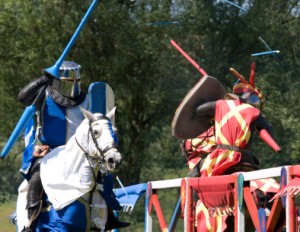 The May Day joust of 1st May 1536 should have been like every other May Day joust. It should have been a day of celebration, of fun and joy. Instead, it was to be the first outward sign that something was wrong in Tudor Paradise.
The May Day joust of 1st May 1536 should have been like every other May Day joust. It should have been a day of celebration, of fun and joy. Instead, it was to be the first outward sign that something was wrong in Tudor Paradise.
Anne Boleyn sat watching the May Day jousting at Greenwich with her husband, King Henry VIII, who was sitting it out for the first time due to his accident in the January. Anne was blissfully unaware of the interrogation of Mark Smeaton the day before, although she may have had an inkling that something was going on. She may well have been pre-occupied about a conversation she had had with Sir Henry Norris, her husband’s Groom of the Stool; a conversation which could be misconstrued and used against her by her enemies. Anne may also have been concerned about her husband’s interest in a certain Jane Seymour, one of her ladies, but she had no clue about the events which were shortly to unfold.
In his poem “De la royne d’Angleterre”,1 Lancelot de Carles, secretary to the French ambassador, wrote of how there was no sign of anything being wrong between the King and Norris during the joust. He describes how Norris was armed and ready to joust, but his horse refused to run. The King stepped in and offered Norris his own horse – an act of kindness and chivalry. The Queen’s brother, George Boleyn, was also involved in the joust. He led the challengers and Norris led the defenders.2
Everything changed at the end of the joust when the King suddenly got up, abandoning his wife, and riding instead to Westminster with Norris. According to George Constantine, one of Norris’s servants, the King interrogated Norris the whole way and offered him a pardon “in case he wolde utter the trewth.”3 Gilbert Burnet, Bishop of Salisbury, corroborated this offer of a pardon, writing that Norris said “that in his conscience he thought her innocent of these things laid to her charge; but whether she was or not, he would not accuse her of anything; and he would die a thousand times, rather than ruin an innocent person.”4 A courageous answer.
The Spanish Chronicle explains that Norris’s interrogation was due to Smeaton’s confession:
“The Secretary at once [after Smeaton had confessed] wrote to the King, and sent Mark’s confession to him by a nephew of his called Richard Cromwell, the letter being conceived as follows: “Your Majesty will understand that jealous of your honour, and seeing certain things passing in your palace, I determined to investigate and discover the truth. Your Majesty will recollect that Mark has hardly been in your service four months and only has £100 salary, and yet all the Court notices his splendour, and that he has spent a large sum for these jousts, all of which has aroused suspicions in the minds of certain gentleman, and I have examined Mark, who has made the confession which I enclose to your Majesty in this letter.”5
The Spanish Chronicle then has the King leaving by boat for Westminster, whereas Constantine has them riding. Norris would not confess to anything and protested his innocence, but he was taken to the Tower of London the next morning.
Taken from The Fall of Anne Boleyn: A Countdown by Claire Ridgway.
Also on this day in history
The Evil May Day Riot of 1517 – A mob of young apprentices and labourers gathered at St Paul’s and then went on a rampage through the streets of London, causing damage to property and hurting those who stood in their way. The rioters of this Evil May Day Riot focused particularly on damaging and looting the shops and houses which belonged to foreign traders, such as the shoe shops around Leadenhall and the house of French merchant John Meautys.
Arrests were made by the Duke of Norfolk and his men. On 4th May, thirteen people were executed, and on 7th May John Lincoln was executed. Others were saved by the intercession of Henry VIII’s wife, Catherine of Aragon, and his sisters, Margaret and Mary, who pleaded with him to spare them, although, as Noble points out, this was probably a PR exercise thought up by Henry or Wolsey.
(Extract taken from On This Day in Tudor History by Claire Ridgway.
Notes and Sources
- Ascoli,George (1927) La Grande-Bretagne Devant L’opinion Française Depuis La Guerre De Cent Ans Jusqu’à La Fin Du XVIe Siècle, vv. 495–508
- Wriothesley, Charles (1875) A Chronicle of England During the Reigns of the Tudors, from A.D. 1485 to 1559, 35.
- Constantine, George (1831) Archaeologia, or, Miscellaneous Tracts Relating to Antiquity, 23:64.
- Burnet, Gilbert (1865) The History of the Reformation of the Church of England, 206.
- Hume, Martin Andrew Sharp (1889) Chronicle of King Henry VIII. of England: Being a Contemporary Record of Some of the Principal Events of the Reigns of Henry VIII. and Edward VI. Written in Spanish by an Unknown Hand, 62–63.